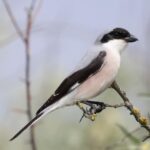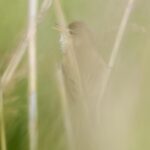A North Norfolk summer day tour today – the plan was to explore the farmland inland in the morning and drop down to the coast for the afternoon. It was a lovely day, bright & sunny, with a good breeze blowing which served to keep down the heat haze and keep us from overheating as well!
Once again, we meandered our way along the country lanes and parked up by one of our favourite farmland tracks. As soon as we got out of the car, we could hear Yellowhammers singing either side of us, the familiar sound of a ‘little-bit-of-bread-and-no-cheeeeese’ as it was always described when we were young. We found one male perched up in the top of a hawthorn, its bright yellow head glowing in the sunshine.
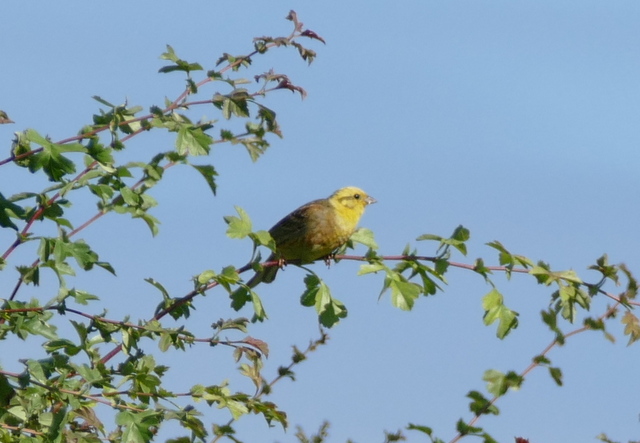 Yellowhammer – there were several males singing in the hedgerows today
Yellowhammer – there were several males singing in the hedgerows today
Many birds have fledged young now and we encountered several family parties on our way. A little group of Whitethroats were feeding in the overgrown vegetation between the track and the hedge and they flew ahead of us as we walked. When one of the adult Whitethroats flew up into the bottom of the hedge, one of the juveniles flew up with it, begging, and was duly fed. A family party of Blue Tits came along the hedge as well, calling noisily.
There were lots of butterflies along the verge too, flitting about in the vegetation. At this time of year, Meadow Browns and Ringlets tend to predominate and there was no shortage of those today. The Ringlets are a little faded now – they are much blacker when fresh – and rather brown themselves, but quite a bit smaller than the Meadow Browns and noticeably different when perched. There were also several Gatekeepers and Small Tortoiseshells. In the shorter grass along the track itself, we flushed several small orange butterflies, fast flying skippers. On close inspection of the ones we got to see perched, we could see distinctive black-tipped antennae, the key distinguishing feature of the Essex Skipper.
 Essex Skipper on clover flower – note the black-tipped antennae
Essex Skipper on clover flower – note the black-tipped antennae
From up on the higher ground, we stopped at a place with a good panoramic view over the surrounding countryside. Here we stood for a while and scanned for raptors. We certainly saw a good selection. Several Buzzards circled over the trees, hanging in the breeze or drifted out over the fields.
There is lots of farming activity at the moment – the wheat and barley are ripe and ready and the combine harvesters are out. We saw several Kestrels taking advantage of the disturbance to catch small mammals forced out from the crop as it was cut. The Yellowhammers and Linnets were making hay in the sunshine too, flying in and out of the fields presumably to try to find any insects or spilt grain, though there is unfortunately precious little of the latter these days with modern machinery. The local Carrion Crows were looking to cash in on the bounty as well, but were chased off by the resident raptors when they got too close.
We stood here for a while, watching the interplay between modern industrial farming activity and the wildlife which tries to make a living here. Then, as we turned to leave, a pair of Grey Partridge burst noisily from the verge and disappeared into the uncut crop on the other side.
As we drove off, we could see an Oystercatcher sitting in a horse paddock. It appeared to be nesting, tucked down in the short grass next to a couple of dock rosettes. A little further on, its partner stood on the grassy verge, looking on warily. While often thought of as coastal birds, Oystercatchers do also attempt to nest inland and often some way from water. However, productivity can be pretty poor in the modern industrial farming landscape.
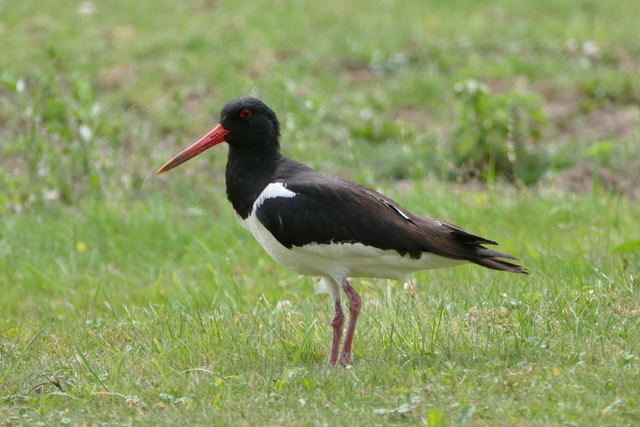 Oystercatcher – its partner attempting to nest in a nearby horse paddock
Oystercatcher – its partner attempting to nest in a nearby horse paddock
Our next destination was Choseley. On the way there, we saw several more Yellowhammers along the sides of the roads or on the wires and a couple more families of Kestrels, again around the freshly cut stubble fields. We stopped briefly to admire a Stock Dove coming down to drink at a puddle. We drove around the back lanes first, to see if we could find the pair of Corn Buntings we have seen regularly in recent weeks. There was no sign as we drove past at first, but on the way back down, one of the birds flew out across the field behind us. We reversed back and could see it had landed in the top of a single weed growing in the middle of the barley. When it flew back into the hedge, we got out and got the scopes onto it – and promptly found a second Corn Bunting perched in the hedge nearby.
Round at the drying barns, it was fairly quiet again, as it has been in recent days. A dog walker was just coming out of the footpath and there was lots of activity around the barns themselves, presumably with the harvest being brought in. There were several Linnets on the wires, hungrily eyeing up the grain spread on the concrete. A pair of Collared Doves flew in to join them. A Marsh Harrier quartered the fields along the ridge. We decided to drop down to Titchwell for lunch.
Feeling suitably refreshed afterwards, we walked out across the reserve. At the reedbed pool, a single Red-crested Pochard was amongst the ducks out on the water – we noted its mostly dark bill with pinkish tip. There was a good selection of wildfowl on here again today – also a couple of Common Pochard diving next to the reeds, a little group of Gadwall at the front, plus a couple of Teal and a Shoveler further back. However, with the drakes all in female-like eclipse plumage now, none of them are arguably looking their finest! The juvenile Great Crested Grebe was hiding at the back by the reeds, but we couldn’t see its parents today.
The water levels on the freshmarsh are perfect for waders at the moment and there has been an amazing number and variety of birds present in the last week or so. Today was no exception – the mud was alive, covered with them. The counts of Avocets in particular have been hitting record levels – presumably post-breeding birds from elsewhere moving in to take advantage of the perfect feeding conditions. We counted at least 400 today, but lots more were asleep on the islands. The official reserve counts have been over 600 in recent days!
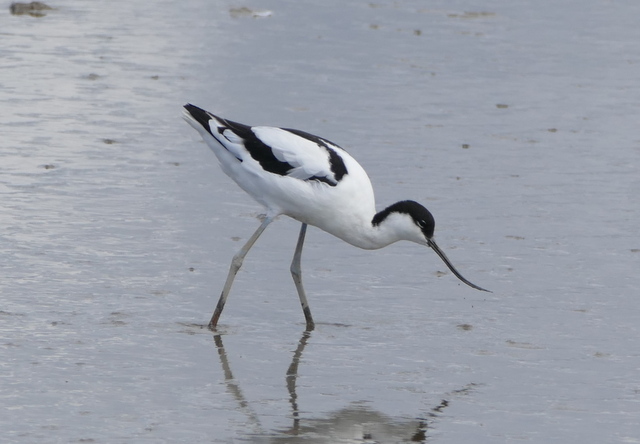 Avocet – amazing numbers gathering on the reserve at the moment
Avocet – amazing numbers gathering on the reserve at the moment
The variety of waders can change all the time and the surprise today was the number of Dunlin present. We counted a minimum of 375, the vast majority adults still sporting their summer plumage black bellies, but amongst them a few juveniles with black streaks below. Hiding in with the Dunlin, we could see a couple of Curlew Sandpipers as well. Slightly larger, and with a longer, more downcurved bill, they were both adults still partly in summer plumage, their chestnut underparts increasingly dappled with white.
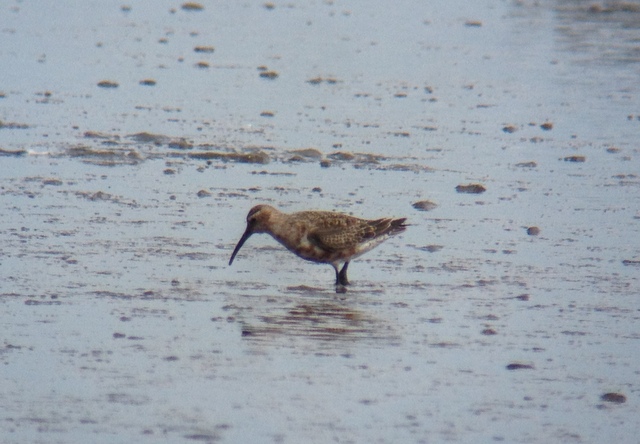 Curlew Sandpiper – two moulting adults were in with the Dunlin today
Curlew Sandpiper – two moulting adults were in with the Dunlin today
There have been several Little Stints here in recent days, but at first we could only find one with the Dunlin flock. Easy to pick out if you look really closely, the Little Stint is noticeably smaller, with a shorter bill and bright white belly. It was only later, while we were looking at a couple of Golden Plover bathing on the edge of one of the islands, that we spotted the other six Little Stints, hiding amongst the rocks on the shoreline. All the waders had apparently been flushed earlier by a raptor and the Little Stints had obviously decided to vacate the open mud for a while for the safety of some cover. A couple of bright orange summer-plumaged Knot were also nearby. Later, as we walked back, all the Little Stints were back out again with the Dunlin feeding on the open mud.
The numbers of Ruff have also been impressive in recent days, though not in the sheer quantity of some of the other waders. They are also more scattered around the freshmarsh rather than gathered in a single mass, making them harder to cound. We didn’t try today – but numbers have been over 60. However, we did spend some time admiring the amazing variation in plumage. The male Ruffs in summer come in a wide variety of colours and now with the vagaries of moult to add in as well, they can be one of the most confusing waders to identify. There were also several females, sometimes known as Reeves, amongst them – smaller and less garishly plumaged.
 Ruff – large numbers present today but in a confusing array of plumages
Ruff – large numbers present today but in a confusing array of plumages
There were perhaps fewer Black-tailed Godwits on the freshmarsh than in recent days, but still very good numbers and some very close to Island Hide giving us great views. Again, they were in a variety of plumages, with more moulting adults now still with mostly bright chestnut bodies and black belly bars, to add to the more variable 1st summer birds, some of which have been present all summer. We spent some time looking at them and talking about the key identification features, Black-tailed Godwit versus Bar-tailed Godwit. The black tail is usually hidden by the folded wings at rest, but some of the birds were dropping their tails while feeding so we could see the solid black.
 Black-tailed Godwits – in bright summer & grey winter plumage
Black-tailed Godwits – in bright summer & grey winter plumage
Out towards the back of the freshmarsh, where the water was deeper, we could see several Spotted Redshanks – a closer look revealed at least seven today. Some were still mostly in black summer plumage, but with an increasing amount of white feathering appearing now in the underparts, but a couple were looking increasingly silvery-grey. Three Greenshanks were walking around feeding very actively. Several Common Redshanks completed the set and provided a good comparison.
Looking closely amongst the vast hordes of waders, we could pick out a few individuals of other species as well. A couple of Common Sandpipers were feeding unobtrusively round the edges of the freshmarsh. A juvenile Yellow Wagtail nearby was a good spot. A Whimbrel dropped in briefly to rest on the edge of one of the islands, before flying off calling, its distinctive repeated piping whistle sounding a little like it is laughing. A 1st summer Little Gull amongst the Black-headed Gulls looked obviously much smaller by comparison.
 Whimbrel – this one dropped in briefly before flying off west calling
Whimbrel – this one dropped in briefly before flying off west calling
We could see five Spoonbills from Island Hide, asleep on one of the islands. Typical Spoonbill behaviour! From round at Parrinder Hide we got a much closer look at them, and several even woke up briefly. We could see there were three shorter-, darker-billed juveniles and two adults – when the latter finally put their heads up, we could see the bright yellow bill tip.
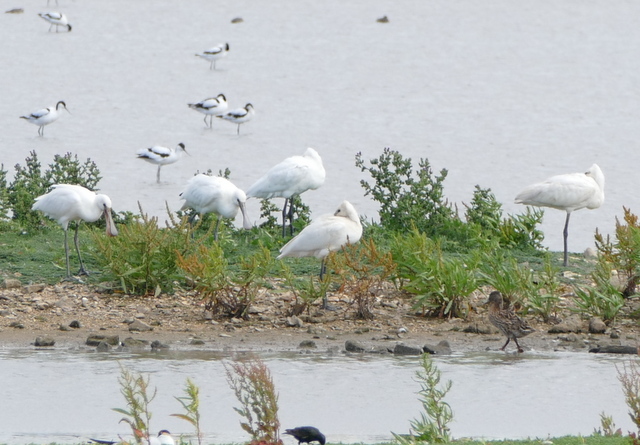 Spoonbills – five, including three juveniles, were mostly sleeping!
Spoonbills – five, including three juveniles, were mostly sleeping!
There were several Little Ringed Plovers on the exposed mud in front of Parrinder Hide, a mixture of adults and juveniles. We could see the golden eye ring on the adults and the ghost of a paler eye ring on the juveniles. Out on the open mud with the other small waders there were a couple of Ringed Plovers as well.
 Little Ringed Plover – an adult sporting a golden yellow eye ring
Little Ringed Plover – an adult sporting a golden yellow eye ring
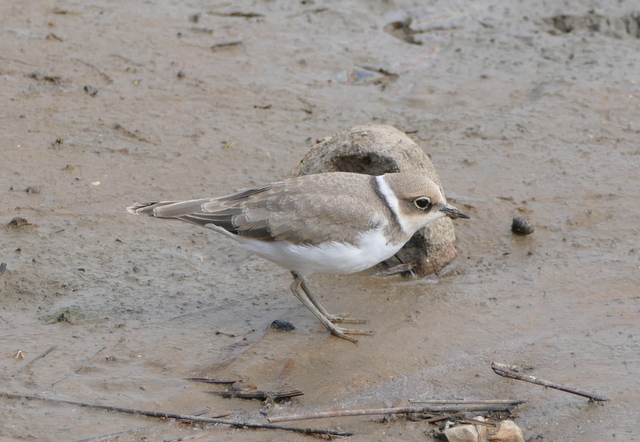 Little Ringed Plover – a juvenile with a ghosting of the adult’s eye ring
Little Ringed Plover – a juvenile with a ghosting of the adult’s eye ring
The Volunteer Marsh and tidal pools were quiet today, as they have been in recent weeks. There were several butterflies along the verges. A smart Gatekeeper basking on the path was clearly struggling for some reason when it finally flapped off into the grass.
 Gatekeeper – basking on the path
Gatekeeper – basking on the path
Out on the beach, the sea itself looked fairly quiet. We managed to find a little group of four Common Scoter out on the water and several Sandwich Terns were flying back and forth offshore, fishing. The tide was out and the rocks were exposed. There were several Curlew feeding around the rock pools and nearby, we picked up a single, smaller, sleeker Whimbrel. While we were standing there, we also heard several more Whimbrel flying past behind us, calling. In amongst the birds on the rocks, we also picked out a few Bar-tailed Godwits – it was good to look at the differences from the Black-tailed Godwits we had seen earlier.
We picked up three Turnstones as they flew and when they landed we could see they were still in bright summer plumage, with rusty orange backs and white faces. A closer look down on the shore revealed a couple of Dunlin and next to them a little group of Sanderling, looking rather different to the bright silvery grey and white birds we see here in the winter in their spangled summer plumage.
Then unfortunately it was time to head back. Still, what an amazing spectacle of waders here today – the sheer number and the great variety.

